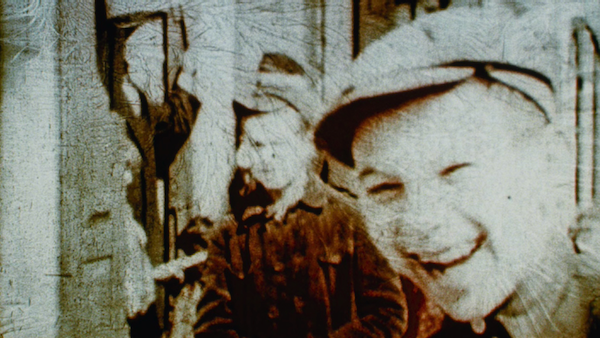Movie review by Greg Carlson
The only nonfiction film to be selected for the 2022 Sundance Film Festival’s Spotlight section – a prestige category highlighting movies that have already premiered to acclaim elsewhere – Bianca Stigter’s feature-length directorial debut “Three Minutes: A Lengthening” is an inspired piece of cinematic archaeology. Stigter does exactly what the title of the piece invitingly and enigmatically implies: she examines a short section of 16mm home movie footage from every possible angle, stopping and starting and running and re-running the images without ever cutting to talking heads.
The film in question was taken by David Kurtz in 1938 while on vacation in Europe and shows some of the Jewish inhabitants of Nasielsk, a small town north of Warsaw where Kurtz was born. Kurtz’s grandson Glenn discovered the reel in a closet in 2009. Realizing the celluloid was brittle, faded, and on the very edge of salvageable, the movie was rescued and restored through the efforts of the United States Holocaust Memorial Museum. A lesson plan designed for grades seven to twelve on the museum’s website uses the Kurtz footage to “engage students in understanding both the individuality of Jewish lives affected by or lost in the Holocaust and the cumulative effects of the Holocaust on communities.”
Within seven years of Kurtz’s visit, only about one-hundred of Nasielsk’s approximately 3000 Jews would be alive.
Stigter’s excellent film, which does indeed lengthen the Nasielsk section of Kurtz’s home movies to a total running time of just under seventy minutes, works first as a rare and valuable artifact, a strange and unexpected crystal ball allowing us to peer into an ordinary moment in time just prior to the unthinkable arrival of and occupation by the German Nazis who would send so many to death. But Stigter’s direction transforms the film and story into so much more than a historical lesson on atrocity and genocide. The narration, delivered by Helena Bonham Carter, constantly asks the viewer to imagine contours, possibilities, and meanings about the act of seeing, witnessing, and understanding.
Several writers have already compared Stigter’s approach to the frame-by-frame scrutiny bestowed upon Abraham Zapruder’s 8mm documentation of the assassination of John F. Kennedy in Dallas, Texas on November 22, 1963. But instead of capturing a tragedy, “Three Minutes: A Lengthening” anticipates one; in a matter of months, the people we observe smiling and waving at the novelty of being in front of Kurtz’s camera will be removed to places like Treblinka.
In the Kurtz footage, around 150 individuals are seen. Of those 150, fewer than a dozen were positively identified by name. It is one of the film’s most sobering revelations, intensified by the passion in Glenn Kurtz’s voiceover as he details the efforts to track any survivors who might have been in his grandfather’s viewfinder. Sections like this one, or the one in which another person methodically decodes the blurry letters on a briefly-visible grocery shop sign, bring into proximity the limitations and the promises of film. That thoughtful metanarrative contemplation and Stigter’s exciting structural choices make for a profound experience.
